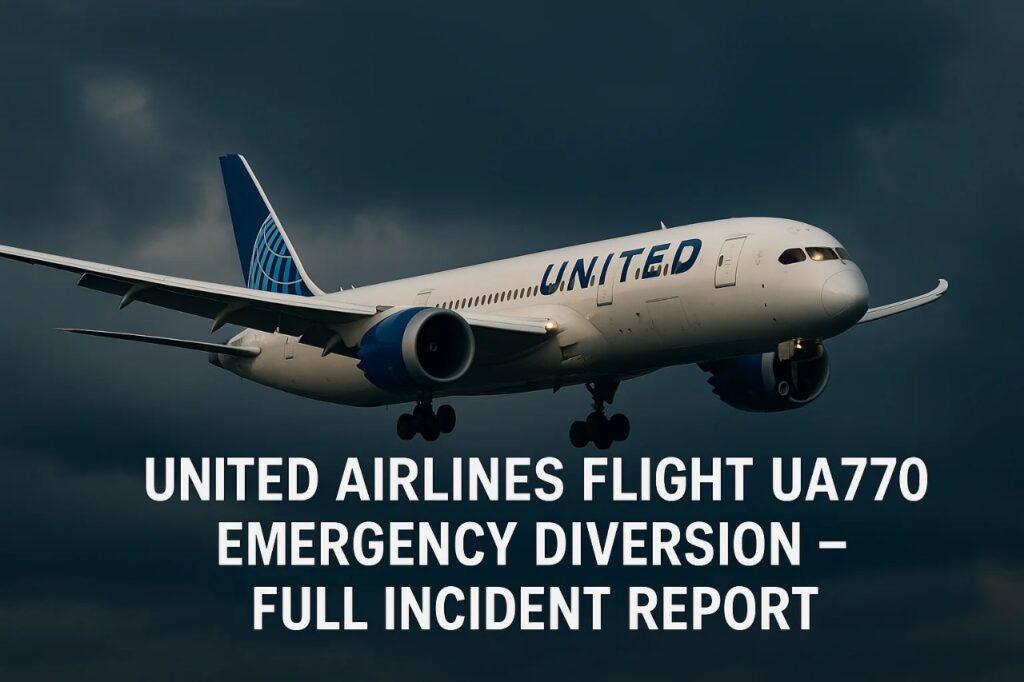Introduction
United Airlines Flight UA770 experienced an unplanned but well-managed emergency diversion, demonstrating the professionalism of its crew and the effectiveness of aviation safety protocols. This case highlights how trained aviation professionals handle mid-air technical issues, why diversions occur, and how passengers are supported during such events.
In this report, we cover the full timeline of the incident, the technical cause, crew and passenger reactions, expert insights on aviation safety, and the key lessons learned from UA770’s diversion.
What Happened to United Airlines Flight UA770 – Full Timeline
United Airlines Flight UA770, operated by a Boeing 787-9 Dreamliner, departed Barcelona bound for Chicago with 257 passengers and 12 crew members. About 90 minutes into the flight, while cruising at approximately 37,000 feet, the crew detected a cabin pressurization issue.
Recognizing the potential risks, the pilots declared a general emergency (code 7700) and diverted to London Heathrow Airport, known for its advanced emergency response facilities.
Key Facts:
- Aircraft: Boeing 787-9 Dreamliner (Tail number N26902)
- Route: Barcelona (BCN) → Chicago (ORD)
- Issue Detected: Cabin pressurization problem mid-flight
- Diversion Airport: London Heathrow (LHR)
Timeline:
| Time (Local) | Event |
|---|---|
| 14:30 CEST | Departs Barcelona (BCN) for Chicago (ORD) with 257 passengers + 12 crew |
| 16:00 CEST | Crew detects cabin pressurization anomaly at 37,000 ft |
| 16:05 CEST | Declares emergency (Squawk 7700) |
| 16:55 BST | Safely lands at London Heathrow (LHR) Runway 27R |
| 17:30 BST | Passengers disembark with airline assistance |
Causes of the United Airlines Flight UA770 Diversion
The diversion was triggered by a cabin pressurization malfunction. While oxygen masks did not deploy, the issue posed a potential risk of reduced oxygen levels, which can cause medical emergencies if not addressed.
Possible contributing factors included:
- Sensor malfunction
- System leak or pressure control failure
Cabin pressurization systems are critical for passenger safety, and any anomaly requires immediate pilot action to protect passenger health.
How the Crew of United Airlines Flight UA770 Responded
The UA770 crew followed emergency procedures precisely:
- Declared the emergency and coordinated with air traffic control
- Maintained calm, clear communication with passengers
- Coordinated with Heathrow’s emergency teams for a priority landing
The captain’s professional announcements and the flight attendants’ reassurance helped maintain order and reduce anxiety.
Passenger Experience on United Airlines Flight UA770
Passengers reported initial concern, but the crew’s composure kept the situation calm. Flight attendants provided safety instructions, reassurance, and regular updates throughout the diversion.
Many passengers praised the crew’s handling of the situation, noting that clear communication and a lack of panic made a significant difference.
Safety Procedures Followed on United Airlines Flight UA770
During the incident, the crew and ground teams executed established aviation safety protocols:
- Emergency communication with passengers
- Priority landing clearance from ATC
- Emergency vehicles and medical teams on standby
- Post-landing inspection of the aircraft
Post-Incident Actions by United Airlines After UA770 Diversion
Following the safe landing at Heathrow, United Airlines:
- Rebooked affected passengers and provided accommodations and meal vouchers
- Issued public statements reaffirming its commitment to safety (Source: United Airlines)
- Grounded the aircraft for a thorough inspection
- Cooperated with EASA (European Union Aviation Safety Agency) and FAA (Federal Aviation Administration) investigations
Expert Opinions on United Airlines Flight UA770 Emergency Diversion
Aviation experts note that emergency diversions occur in roughly 1 out of 1,500 flights. While rare, they are a vital safety measure. Key takeaways from UA770’s case:
- Pilot and crew training is essential to successful outcomes
- Modern aircraft technology aids in early detection of technical issues
- International ATC coordination enables safe and efficient diversions
For more on how pilots handle similar scenarios, see our in-depth guide to in-flight emergencies.
Lessons Learned
The UA770 incident reinforced several points:
- Passenger safety is the top priority in all operational decisions
- Ongoing investment in crew training and aircraft maintenance is essential
- Clear communication is critical in maintaining passenger trust during emergencies
FAQs
Q1: What caused the emergency diversion of United Airlines Flight UA770?
A cabin pressurization issue was detected mid-flight, prompting a diversion to London Heathrow.
Q2: How did the crew handle the emergency?
They followed safety protocols, communicated clearly, and coordinated with ATC for a safe landing.
Q3: What support did passengers receive after the diversion?
United Airlines provided rebooking, accommodations, and meal vouchers.
Conclusion
United Airlines Flight UA770’s emergency diversion stands as a textbook example of aviation safety in action. The crew’s professionalism, adherence to protocols, and effective communication ensured a safe outcome for everyone on board. The incident serves as a reminder of the value of preparedness and coordination in maintaining passenger safety in air travel.



very good articial